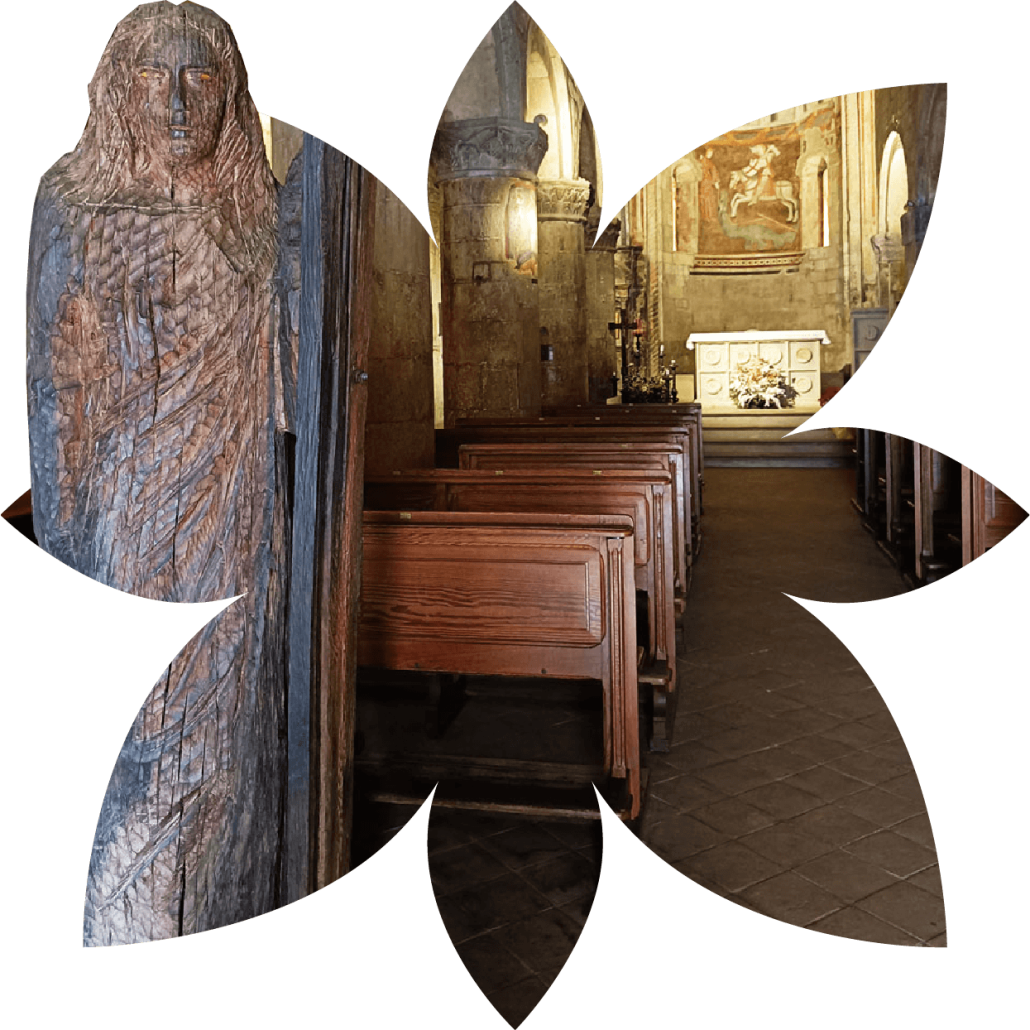The Parish Church of San Giorgio

The parish church named Pieve di San Giorgio in Vigoleno, located in the heart of the medieval village, is a perfect example of Romanesque architecture.
Built in the 12th century in local stone, the church stands out for its sober but imposing façade: from the small churchyard, the splayed portal creates a visual effect that leads to the interior. Two telamons with enigmatic faces hold up the door architrave: above them, the beautiful lunette with St. George (school of Benedetto Antelami c. 1150-1230), the knight always depicted in the act of slaying a dragon placed beneath him, while an angel figure emerges from the stone behind him.
THE INTERIOR OF THE PARISH CHURCH
The three-nave interior is striking for its cosy and evocative atmosphere, with round arches supported by stone columns. At the entrance, visitors are greeted by some very impressive wooden statues: it is the Annunciation by Paolo Perotti, a contemporary Piacenza sculptor.
The decorations feature medieval frescoes depicting sacred scenes and religious motifs. The apse is of particular interest, where fragments of wall paintings dating back to the first centuries of the parish church can be admired. The sculptures and carvings on the columns and capitals reveal the skill of the local craftsmen, who were able to blend religious symbolism and Romanesque artistic style.
In the middle of the nave, the third column on the right is a catalogue of allegorical figures and decorations. The capital depicts a two-tailed mermaid. There are no unanimous interpretations of its meaning, even within Christian iconography: some experts associate it with the sin of lust, while others give it a different meaning, linked to falsehood and duplicity.
Below the mermaid, three mysterious figures with belts knotted at the waist hold hands: one interpretation sees here a reference to the Trinity. Continuing the reading of the capital, one encounters a character with their eyes covered: although the interpretation is uncertain, these figures express great strength and impose a pause.
On the left, there is a portrait of St. Benedict on a column, identified by an inscription accompanied by ‘1427 19 iulii’, a date considered to be reliable for dating the work.
Continuing to the altar, you will note the strangeness of the pillar separating the central apse from the one on the left, rich in figures and decorative elements: at the top two sea monsters or dolphins join their tails, at the sides a riot of twisted columns, winged putti and rosettes. On the pedestal is a coat of arms that can be traced back to the Scotti family, who became owners of Vigoleno castle in 1389 and feudal lords from 1404; scholars believe the artefact may celebrate their arrival in the village and, perhaps, the start of renovation work in the parish church.
SAINT GEORGE SLAYING THE DRAGON AND OTHER FRESCOES
In the central apse, St George is the protagonist of the 15th-century fresco in which he slays the dragon to free the princess. The scene is set in an interior environment surrounded by architecture, an unusual situation. The saint defends himself with a crusader shield – the red cross on a white field is known as the Cross of St. George – and wears a tunic with the same cross. The princess wears an elegant red pelisse, as worn in medieval fashion. In the apse basin, another fresco depicts the Coronation of the Virgin.
Other medieval frescoes are preserved on the side walls: we admire the Madonna del Latte in the left aisle, and a little further on Saints Cosma and Damian, next to the Crucifixion. It is not so common to find them in these parts: we recognise them because the two medical brothers are depicted with the attributes associated with their profession, the surgical instruments.
PIEVE DI VIGOLENO: HOW TO VISIT IT
A visit to the village of Vigoleno must include a stop at the parish church of San Giorgio.
The church is open to the public every day from 9 a.m. to 6 p.m. except Tuesdays.
If you find it closed, you can go to the trattoria across the street and ask it to be opened.
On 23 April, the patron saint St George is celebrated with a mass and a procession accompanying the wooden statue of the saint carried on the shoulders to the square outside the fortified walls.
DISCOVER OUR VISIT ROUTES
EVENTS IN VIGOLENO
WE ARE IN THE UPPER VAL D'ARDA
The Alta Val d’Arda is the easternmost Apennine part of the valley in the province of Piacenza, bordering on the province of Parma.
It has the irresistible charm of a land waiting to be discovered: a treasure chest of history, art, nature and flavours, for those who love to travel far from mass tourism.




















